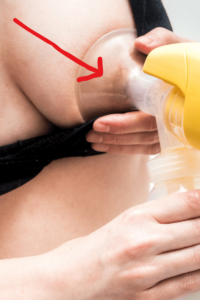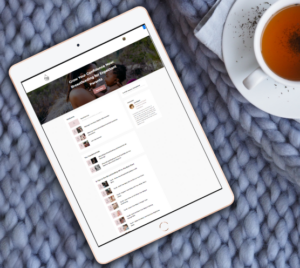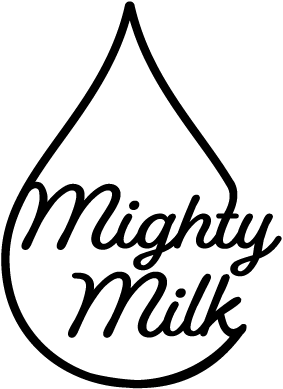About Author: Hi, I’m Kate 👋 I’m a Lactation Educator Counselor and the founder of Mighty Milk, a Baby Registry Certified Expert, and a mom of 2. I share info that helped me go from struggling with breastfeeding and pumping to thriving with both!
If you’re a total beginner at using a breast pump, and you want to learn what you need to know to get started, you’re in the exact right place. Maybe you’re an expectant parent you feel like you have no idea when to pump, nevermind how to use it. Or maybe you’re a parent of a newborn and even looking at your breast pump feels overwhelming. (I’ve been there and I get it.)
I’m going to teach you the steps that helped me go from struggling with breastfeeding and pumping with my first baby to thriving with my second.
I was exactly in your shoes just a couple of years ago. With my first baby, even setting up the pump felt extremely overwhelming. What are all those buttons for, anyway? With my second baby, I knew when to pump and how to pump in a way that made the most of my time. Now I’m going teach you exactly the steps that helped me get the most out of each pumping session.
Step 1: Know reasons why you should take out the pump.
Pumping is really common today, but know that if you want to nurse you baby at the breast, and you’re not going to be separated from your baby, you definitely don’t need to pump. Many moms don’t love pumping. Hooking yourself up to a machine is not the same as feeding your baby, and biologically, nature did not intend us to be pumping. It can be stressful seeing your milk trickle into a bottle. You might question your supply when everything could be totally fine. Or you could pump too much, leading to engorgement and other painful issues. Plus, bottle feeding requires a lot of cleaning. Many first time parents don’t know that it can often be really hard to get a newborn baby to accept a bottle in the first place. That being said, there are some great reasons to use a breast pump. Some parents, for a variety of reasons, don’t want to or can’t nurse. In that case, a pump is an awesome alternative for you to get your baby that liquid gold. Another obvious reason that to use a breast pump is if you’re going to be separated from your baby for any reason. Maybe you’re going to work or a doctor’s appointment or anything else and you can’t bring your baby along. Pumps allow you to maintain your milk supply and leave behind a bottle for your baby. There are other reasons to use a pump, but those are two common ones.
Step 2: Set realistic expectations
There are a lot of images on social media with freezers packed to the brim with milk storage bags. These represent a ton of time and effort for those parents. But know that there is such a thing as pumping too much. Your goal is to feed your baby–not your baby AND your fridge. How much you will pump will depend on lots of factors, including whether or not you are nursing at the breast, when you last nursed, and many others. Try not to compare yourself to other pumping parents. If you have concerns about how much you are pumping, you can and should get support from an IBCLC. More about that in step 6.
Step 3: Make sure your flanges fit you correctly.
Flanges are these things that look like a funnel and fits directly over you nipple.

It is super important to make sure your flange fits you right and most parents have flanges that do not fit them well. Using the correct size flange will help you get the most breast milk out of each pumping session. On the other hand, using a poorly fitting flange can lead to nipple pain or even injury. You can measure yourself for a proper fit, but you’ll want to wait until after your baby is born. In the comments I’m linking to a guide that shows you how to measure yourself. Most of the time you’ll need to order new flanges from a site like Amazon. They usually cost about $20. And trust me, it is worth it.
Step 4: Boost Your Output with Hands-On Pumping
Step #8. Boost your output with hands-on pumping. What if I told you there was a technique that could increase the amount of milk that you get by two or even three times? Well, this is the best pumping tip ever, so if you’re distracted right now, come back to me. When I do breast compressions while I pump, I usually get about 3 ounces. All it is is basically a light massage. When I don’t do breast compressions, I get an ounce or less. It makes a huge difference. In the full class, you’ll learn exactly how to do breast compressions while you pump, with footage of a mother doing it properly.
Step 5: Experiment with the pump settings
Everyone responds to the breast pump differently. Try playing with the settings, and see what works best for you over time. Pumping should not feel painful.

Step 6: Reach out for help from an IBCLC if you need it
Not sure if you’re pumping enough milk? Worried about pumping too much milk? Are you feeling overwhelmed by pumping or need other support? Reach out to an International Board Certified Lactation Consultant, or IBCLC, for help if you’re struggling with breastfeeding OR pumping. IBCLCSs are the lactation experts with the highest credential. Before I gave birth, I didn’t really know what a Lactation Consultant was. And then after my baby was born, I saw my local lactation consultant so frequently I felt like I was living in her office. Many new parents aren’t aware that pediatricians are NOT lactation experts. They get very minimal lactation training. I’m talking like 3 hours of training. IBCLCs can help you with lots of things. Milk supply, nipple pain, pumping, bottle feeding, the list goes on. Challenges with feeding can snowball quickly. I learned this firsthand with my first baby. Reach out for help early and often if you need to. Many US insurance plans cover IBCLC visits so check with your provider.
Can you imagine what a difference it would make for your postpartum life if breastfeeding was going well, and you felt confident and calm?
One thing that is not talked about enough is how much of an outsized role breastfeeding (and pumping!) plays in postpartum life. Feeding your baby IS postpartum life. If you’re a first time mom, maybe you were like me and imagined peacefully rocking your baby in their adorable nursery, everything quiet and calm. But the reality for so many of us is so different. Because when breastfeeding isn’t going well, it can color EVERYTHING. It can impact how you feel about your transition to motherhood. How you feel about your partner. How you feel about your life. But the opposite can also be true. When breastfeeding is going smoothly, the anxiety quiets. The stress and overwhelms drops. Sure, you’ll still be tired and underslept, and you still probably have dishes piling up in the sink, but when you have this confidence, it is a huge shift. And it can make all the difference how you are able to adjust to your new life with your baby.
Maybe you’ll cross your fingers and hope that breastfeeding will go well. Or maybe you’ll comb through Youtube videos or social media groups, trying to piece together advice. But who knows how trustworthy that information will be, and whether it will actually help you. OR you can make the choice to invest in your breastfeeding relationship by following the guidance of an IBCLC who has helped hundreds of families overcome breastfeeding challenges and reach their goals. All of this in just one class, with a few hours of video that can make the difference between whether or not you’re able to reach your breastfeeding goals.
My breastfeeding journey with my babies inspired me to help other families avoid the frustration and difficulty that I felt. I teamed up with the amazing lactation consultant who was literally life changing for me and my family. She is why I was able to breastfeed my second baby successfully. She has worked with hundreds of families reach their feeding goals and now she can help you, too.
I want to invite you to Mighty Milk’s Breastfeeding for Expectant class (we also offer a class called Breastfeeding Your Baby for parents of babies 0-12 weeks who are struggling with breastfeeding.) This class is exactly all of the information that helped me have a successful breastfeeding relationship. And it made a huge difference in helping me have a happier, less stressful transition to postpartum life than I did with my first baby. The class is broken down into short videos that you can watch all at once or over time. So you can change the course of your postpartum life, just by sitting on your couch for an hour or two. And you can grab your partner and watch together, since their support plays an important role in your breastfeeding success.
In this course you’ll learn:
- What’s normal with a breastfed baby
- All about building your milk supply
- How to position your baby to avoid nipple pain
- How to tell if your baby is hungry
- How to tell if your baby is swallowing
- How you can tell when breastfeeding is going well—and when to get help
- Tips for maximizing nighttime sleep
- How to get started with pumping and bottle feeding
- Adjusting to life with a breastfed baby
- How to get out of the house
- Nutrition, coffee, alcohol, and medication
- And so much more
Our classes are rated 5/5 stars on Facebook from parents that have been in your shoes.

I want to make this extra easy for you. I want you to succeed. I want you to be able to have a rewarding breastfeeding relationship, by the way that includes pumping, for as long as you would like. So I’m offering a guarantee. If you finish the class and you’re not satisfied, let me know, and I’ll make it right. Even if you’ve taken a breastfeeding class at your hospital, take this class. I took one with my first baby and it didn’t teach me in the way I needed to learn. Mighty Milk’s class is different. You have nothing to lose and everything to gain.
Click here to sign up and boost your confidence starting immediately. Hope to see you inside!


